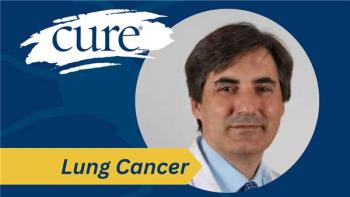
Onivyde May Have Similar Survival Outcomes as Chemo in Small Cell Lung Cancer
Onivyde did not outperform chemotherapy in improving outcomes for patients with relapsed small cell lung cancer, despite having better response rates.
For patients with relapsed small cell lung cancer (SCLC), receiving Onivyde (liposomal irinotecan) as second-line therapy led to similar survival outcomes to chemotherapy, a phase 3 study showed.
Although Onivyde and chemotherapy (Hycamtin [topotecan]) had similar results for median overall survival (OS; time from treatment until death of any cause), researchers found that Onivyde had better outcomes regarding safety.
Specifically, patients in the study with SCLC who received Onivyde had fewer severe treatment-emergent side effects, compared with Hycamtin, researchers noted. Some of these side effects included diarrhea, neutropenia (abnormally low white blood cells) and anemia. Researchers also established that patients had fewer Onivyde discontinuations versus Hycamtin, which demonstrated better tolerability.
“At best, 10% of people with extensive-stage small cell are cured by their initial chemoimmunotherapy,” study co-author Dr. Paul Bunn told CURE®. “That means 90% or more are going to relapse and need a second-line treatment. The current second-line treatments which are [Onivyde] and [Hycamtin]are quite toxic and intravenous and [have] a non-friendly schedule of administration.”
Bunn is the James Dudley Chair in cancer research and distinguished professor of medicine at the University of Colorado.
The study included 461 patients who were randomly assigned to one of two treatments. There were 229 patients who received Onivyde and 232 patients who received Hycamtin.
READ MORE:
At a median follow-up time of 18.4 months, the median OS was 7.9 months in the Onivyde arm and was 8.3 months in the Hycamtin arm, the study showed. The median progression-free survival (PFS) — or the time patients live without their cancer worsening or spreading — was 4 months with Onivyde and 3.3 months with Hycamtin. The difference in OS and PFS were not statistically significant, meaning that researchers could not say with certainty that one treatment regimen is superior to the other.
“This study wanted to look at both [PFS] and [OS]. There was some improvement in both of those but not statistically significant,” Bunn explained. “Unfortunately, while the response rate was a little higher and the PFS was a little longer, and the toxicity was a little less, those were not statistically significant enough for this study to meet its primary endpoint. Therefore, it's highly unlikely that this drug will be developed further commercially for this use or that the [Food and Drug Administration] or the [National Comprehensive Cancer Network] guidelines would indicate that this is an approved therapy.”
Regarding the objective response rate (ORR), the researchers found that it was more than doubled for Onivyde (44.1%) versus Hycamtin (21.6%). ORR is defined as the percentage of patients who either have cancer disappearance or cancer shrinkage after treatment, according to the National Cancer Institute.
Traditional Treatments for Relapsed Small Cell Lung Cancer
For patients with small cell lung cancer, Bunn noted that there are a couple FDA-approved drugs. Two include intravenous Hycamtin and intravenous Zepzelca [lurbinectedin], which received an
With the scheduling Hycamtin requires, Bunn said that more patients likely receive treatment of Zepzelca. “[Hycamtin] has a very unfortunate schedule of being required to be given daily for five days in a row, intravenously, which is quite inconvenient for patients,” he explained.
So, Bunn advised that patients look into available clinical trials to try newer treatment options.
“Since [Hycamtin] and [Zepzelca] and are not especially attractive therapies in terms of their response rates or side effect profiles, there are a number of trials going on of agents that potentially might be more effective and or less toxic,” he said. “Research is important, and it’s highly likely that several new treatments are going to improve outcomes in small cell lung cancer.”
For more news on cancer updates, research and education, don’t forget to





